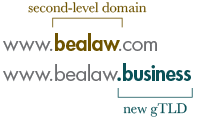New Top-Level Domains: Opportunity or Headache?
A recent explosion of new domain names could profoundly change the digital marketing strategies of businesses and organizations. The regulatory body that coordinates domain names is known as the Internet Corporation for Assigned Numbers and Names (ICANN). ICANN has approved hundreds of new generic top-level domain names (gTLDs) that are starting to become available to the public. Some of the more well-known gTLDs that have been used for many years include .com, .org, or .edu. Examples of new gTLDs that have been approved for release are .blog, .business, .charity, .church, .shop, and .software.
Once the new gTLDs are released, the public will be able to obtain second-level domain names within each gTLD. A “second-level domain” is the text that appears between “www.” and “.com” or any other gTLD.
Registering your name or brand as a second-level domain using one of these new top level domain names could be a powerful way to create a memorable online presence. Because names are issued on a “first-come, first-served” basis, however, the race for available names also presents opportunities for unscrupulous cyber squatters to extort money from legitimate businesses or for knock-off companies to usurp valuable goodwill built up by the original business.
This is a good time to review your need for trademark protection. Any party with a federal or other national or regional trademark registration may register its trademark with ICANN’s Trademark Clearinghouse. ICANN’s Registration provides you with the following benefits:
- “Sunrise” service: Registered trademark owners will have the option to obtain new second-level domain names that use their ICANN-registered trademarks for at least 30 days prior to gTLDs becoming available to the public.
- Notice to Applicant of Prior Registration: Any party who applies for a domain name that uses an ICANN- registered trademark will be notified that its chosen name contains a protected trademark. This may dissuade the party from proceeding further with the application or provide evidence for the trademark registrant to use in a Uniform Domain-Name Dispute-Resolution Policy (UDRP) proceeding.
- Watch Service for ICANN-Registered Trademark Owners: Trademark registrants will be notified if a party attempts to obtain a domain name consisting of the registrant’s trademark. Depending upon the facts, the registrant may be able to take action against that party, such as through a UDRP proceeding or by filing a trademark infringement lawsuit.
ICANN’s Trademark Clearinghouse protection is available for 1, 3, or 5-year terms. ICANN’s release of new gTLDs is expected to last for several years, so trademark owners should implement strategies for protecting their marks. Registration with the Trademark Clearinghouse is an efficient way for trademark owners to monitor domain name registration activity during this period of rapid expansion.
Download a PDF of this article
by Daniel J. Mays
This article is provided for general information and should not be relied upon as legal advice for a specific situation. If you are in need of specific advice or legal representation, please do not hesitate to contact us.
©2014 Bea & VandenBerk

